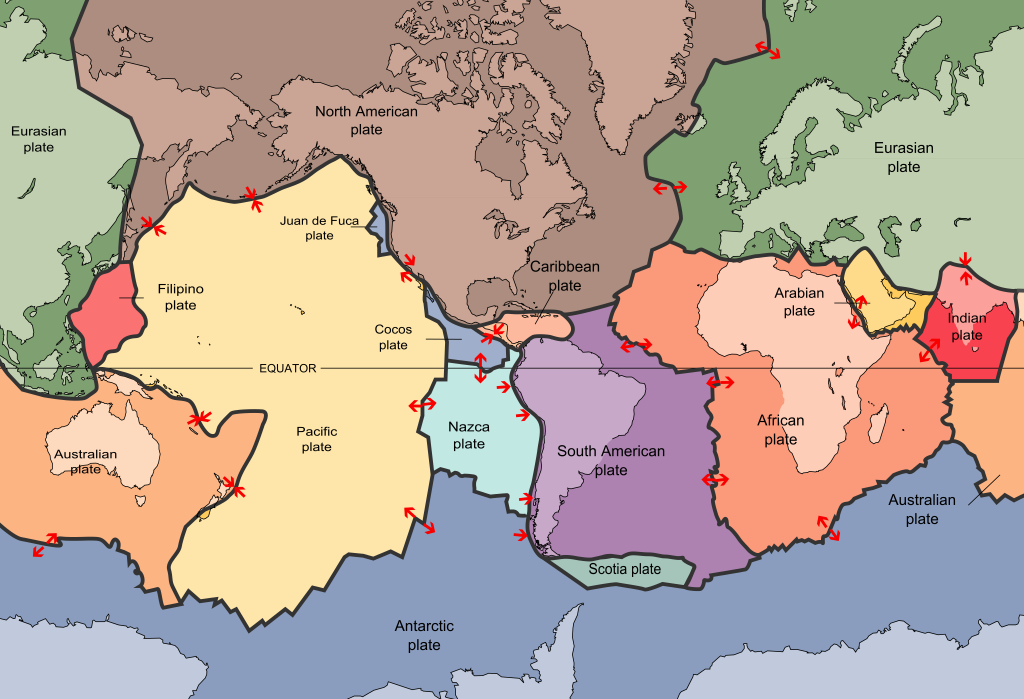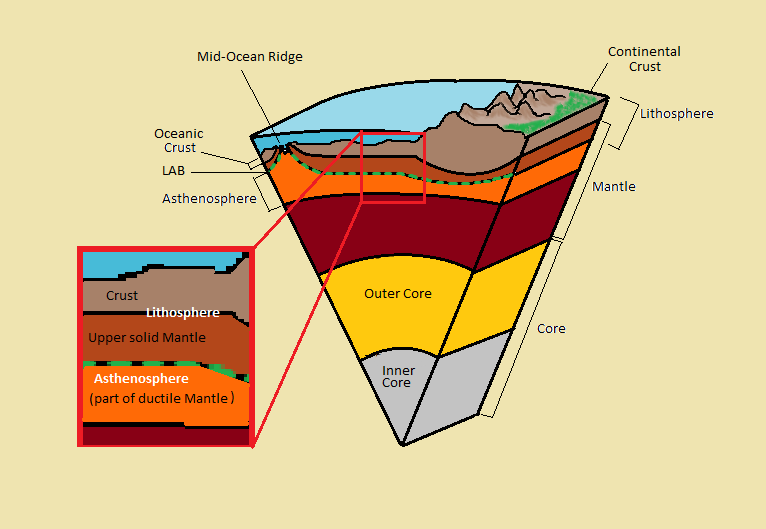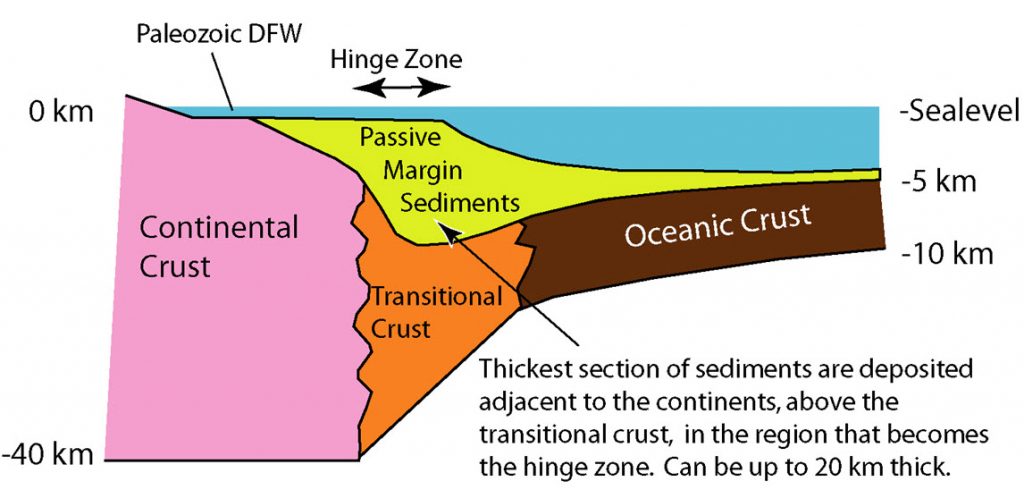2.2: Layers of the Earth
- Page ID
- 6847
In order to understand the details of plate tectonics, it is essential to first understand the layers of the earth. Firsthand information about what is below the surface is very limited; most of what we know is pieced together from hypothetical models, and analyzing seismic wave data and meteorite materials. In general, the Earth can be divided into layers based on chemical composition and physical characteristics.

Chemical Layers
Certainly, the earth is composed of countless combinations of elements. Regardless of what elements are involved two major factors—temperature and pressure—are responsible for creating three distinct chemical layers.
Crust
The outermost chemical layer and the one we currently reside on is the crust. There are two types of crust. Continental crust has a relatively low density and composition similar to granite. Oceanic crust has a relatively high density, especially when cold and old, and composition similar to basalt. The surface levels of crust are relatively brittle. The deeper parts of the crust are subjected to higher temperatures and pressure, which makes them more ductile. Ductile materials are like soft plastics or putty, they move under force. Brittle materials are like solid glass or pottery, they break under force, especially when it is applied quickly. Earthquakes, generally occur in the upper crust and are caused by the rapid movement of relatively brittle materials.

The base of the crust is characterized by a large increase in seismic velocity, which measures how fast earthquake waves travel through solid matter. Called the Mohorovičić Discontinuity, or Moho for short, this zone was discovered by Andrija Mohorovičić (pronounced mo-ho-ro-vee-cheech; audio pronunciation) in 1909 after studying earthquake wave paths in his native Croatia [27]. The change in wave direction and speed is caused by dramatic chemical differences between the crust and mantle. Underneath the oceans, the Moho is found roughly 5 km below the ocean floor. Under the continents, it is located about 30-40 km below the surface. Near certain large mountain-building events known as orogenies, the continental Moho depth is doubled [28].
Mantle

The mantle sits below the crust and above the core. It is the largest chemical layer by volume, extending from the base of the crust to a depth of about 2900 km [29]. Most of what we know about the mantle comes from seismic wave analysis, though the information is gathered by studying ophiolites and xenoliths. Ophiolites are pieces of the mantle that have risen through the crust until they are exposed as part of the ocean floor. Xenoliths are carried within magma and brought to the Earth’s surface by volcanic eruptions. Most xenoliths are made of peridotite, an ultramafic class of igneous rock (see Chapter 4 for explanation). Because of this, scientists hypothesize most of the mantle is made of peridotite [30].
Core
 GFDL or CC-BY-SA-3.0], via Wikimedia Commons" width="335px" height="251px" src="/@api/deki/files/8034/02.2_TolucaMeteorite-300x225.jpg">
GFDL or CC-BY-SA-3.0], via Wikimedia Commons" width="335px" height="251px" src="/@api/deki/files/8034/02.2_TolucaMeteorite-300x225.jpg">
The core of the Earth, which has both liquid and solid layers, and consists mostly of iron, nickel, and possibly some oxygen [31]. Scientists looking at seismic data first discovered this innermost chemical layer in 1906 [32]. Through a union of hypothetical modeling, astronomical insight, and hard seismic data, they concluded the core is mostly metallic iron [33]. Scientists studying meteorites, which typically contain more iron than surface rocks, have proposed the earth was formed from meteoric material. They believe the liquid component of the core was created as the iron and nickel sank into the center of the planet, where it was liquefied by intense pressure [34].
Physical Layers
The Earth can also be broken down into five distinct physical layers based on how each layer responds to stress. While there is some overlap in the chemical and physical designations of layers, specifically the core-mantle boundary, there are significant differences between the two systems.
Lithosphere

Lithos is Greek for stone, and the lithosphere is the outermost physical layer of the Earth. It is grouped into two types: oceanic and continental. Oceanic lithosphere is thin and relatively rigid. It ranges in thickness from nearly zero in new plates found around mid-ocean ridges, to an average of 140 km in most other locations. Continental lithosphere is generally thicker and considerably more plastic, especially at the deeper levels. Its thickness ranges from 40 to 280 km [35]. The lithosphere is not continuous. It is broken into segments called plates. A plate boundary is where two plates meet and move relative to each other. Plate boundaries are where we see plate tectonics in action—mountain building, triggering earthquakes, and generating volcanic activity.
Asthenosphere

The asthenosphere is the layer below the lithosphere. Astheno- means lacking strength, and the most distinctive property of the asthenosphere is movement. Because it is mechanically weak, this layer moves and flows due to convection currents created by heat coming from the earth’s core cause [33]. Unlike the lithosphere that consists of multiple plates, the asthenosphere is relatively unbroken. Scientists have determined this by analyzing seismic waves that pass through the layer. The depth at which the asthenosphere is found is temperature-dependent [36]. It tends to lie closer to the earth’s surface around mid-ocean ridges and much deeper underneath mountains and the centers of lithospheric plates.
Mesosphere
![By Cadmium at English Wikipedia (Transferred from en.Wikipedia to Commons.) [Public domain], <a data-cke-saved-href="https://commons.wikimedia.org/wiki/File%3APerovskite.jpg" href="https://commons.wikimedia.org/wiki/File%3APerovskite.jpg" The atoms are arranged.](http://opengeology.org/textbook/wp-content/uploads/2016/07/Perovskite-300x288.jpg) via Wikimedia Commons" width="330px" height="317px" src="/@api/deki/files/8045/Perovskite-300x288.jpg">
via Wikimedia Commons" width="330px" height="317px" src="/@api/deki/files/8045/Perovskite-300x288.jpg">
The mesosphere, sometimes known as the lower mantle, is more rigid and immobile than the asthenosphere. Located at a depth of approximately 410 and 660 km below the earth’s surface, the mesosphere is subjected to very high pressures and temperatures. These extreme conditions create a transition zone in the upper mesosphere where minerals continuously change into various forms or pseudomorphs [37]. Scientists identify this zone by changes in seismic velocity and sometimes physical barriers to movement [38]. Below this transitional zone, the mesosphere is relatively uniform until it reaches the core.
Inner and Outer Core

The outer core is the only entirely liquid layer within the Earth. It starts at a depth of 2,890 km and extends to 5,150 km, making it about 2,300 km thick. In 1936, the Danish geophysicist Inge Lehmann analyzed seismic data and was the first to prove a solid inner core existed within a liquid outer core [39]. The solid inner core is about 1,220 km thick, and the outer core is about 2,300 km thick [40].
It seems like a contradiction that the hottest part of the Earth is solid, as the minerals making up the core should be liquified or vaporized at this temperature. Immense pressure keeps the minerals of the inner core in a solid phase [41]. The inner core grows slowly from the lower outer core solidifying as heat escapes the interior of the Earth and is dispersed to the outer layers [42].

The earth’s liquid outer core is critically important in maintaining a breathable atmosphere and other environmental conditions favorable for life. Scientists believe the earth’s magnetic field is generated by the circulation of molten iron and nickel within the outer core [43]. If the outer core were to stop circulating or become solid, the loss of the magnetic field would result in Earth getting stripped of life-supporting gases and water. This is what happened, and continues to happen, on Mars [44].
Plate Tectonic Boundaries

At passive margins, the plates don’t move—the continental lithosphere transitions into the oceanic lithosphere and forms plates made of both types. A tectonic plate may be made of both oceanic and continental lithosphere connected by a passive margin. North and South America’s eastern coastlines are examples of passive margins. Active margins are places where the oceanic and continental lithospheric tectonic plates meet and move relative to each other, such as the western coasts of North and South America. This movement is caused by frictional drag created between the plates and differences in plate densities. The majority of mountain-building events, earthquake activity and active volcanism on the Earth’s surface can be attributed to tectonic plate movement at active margins.
![By Jose F. Vigil. USGS ([1]) [Public domain], <a data-cke-saved-href="https://commons.wikimedia.org/wiki/File%3ATectonic_plate_boundaries.png" href="https://commons.wikimedia.org/wiki/File%3ATectonic_plate_boundaries.png" It shows all the types](http://opengeology.org/textbook/wp-content/uploads/2016/07/Tectonic_plate_boundaries.png) via Wikimedia Commons" width="775" src="/@api/deki/files/8051/Tectonic_plate_boundaries.png">
via Wikimedia Commons" width="775" src="/@api/deki/files/8051/Tectonic_plate_boundaries.png">
In a simplified model, there are three categories of tectonic plate boundaries. Convergent boundaries are places where plates move toward each other. At divergent boundaries, the plates move apart. At transform boundaries, the plates slide past each other.
References
- 27. Herak, D. & Herak, M. Andrija Mohorovičić (1857-1936)—On the occasion of the 150th anniversary of his birth. Seismol. Res. Lett. 78, 671–674 (2007).
- 28. Fernandez, L. M. & Careaga, J. The thickness of the crust in central United States and La Paz, Bolivia, from the spectrum of longitudinal seismic waves. Bull. Seismol. Soc. Am. 58, 711–741 (1968).
- 29. Birch, F. Elasticity and constitution of the Earth’s interior. J. Geophys. Res. 57, 227–286 (1952).
- 30. Wyllie, P. J. Ultramafic rocks and the upper mantle. in Fiftieth anniversary symposia: Mineralogy and petrology of the Upper Mantle; Sulfides; Mineralogy and geochemistry of non-marine evaporites (ed. Morgan, B. A.) 3–32 (Mineralogical Society of America, 1970).
- 31. Alfe, D., Gillan, M. J. & Price, G. D. Composition and temperature of the Earth’s core constrained by combining ab initio calculations and seismic data. Earth Planet. Sci. Lett. 195, 91–98 (2002).
- 32. Oldham, R. D. The constitution of the interior of the Earth, as revealed by earthquakes. Q. J. Geol. Soc. London 62, 456–475 (1906).
- 33. Birch, F. Density and composition of mantle and core. J. Geophys. Res. 69, 4377–4388 (1964).
- 34. Hanks, T. C. & Anderson, D. L. The early thermal history of the earth. Phys. Earth Planet. Inter. 2, 19–29 (1969).
- 35. Pasyanos, M. E. Lithospheric thickness modeled from long-period surface wave dispersion. Tectonophysics 481, 38–50 (2010).
- 36. Forsyth, D. W. The Early Structural Evolution and Anisotropy of the Oceanic Upper Mantle. Geophys. J. Int. 43, 103–162 (1975).
- 37. Ito, E. & Takahashi, E. Postspinel transformations in the system Mg2SiO4-Fe2SiO4 and some geophysical implications. J. Geophys. Res. [Solid Earth] 94, 10637–10646 (1989).
- 38. Fukao, Y. & Obayashi, M. Subducted slabs stagnant above, penetrating through, and trapped below the 660 km discontinuity. J. Geophys. Res. [Solid Earth] 118, 2013JB010466 (2013).
- 39. Lehmann, I. P’, Publ. Bur. Centr. Seism. Internat. Serie A 14, 87–115 (1936).
- 40. Engdahl, E. R., Flynn, E. A. & Masse, R. P. Differential PkiKP travel times and the radius of the core. Geophysical J Royal Astro Soc 40, 457–463 (1974).
- 41. Aitta, A. Iron melting curve with a tricritical point. J. Stat. Mech. 2006, P12015 (2006).
- 42. Waszek, L., Irving, J. & Deuss, A. Reconciling the hemispherical structure of Earth/’s inner core with its super-rotation. Nat. Geosci. 4, 264–267 (2011).
- 43. de Wijs, G. A. et al. The viscosity of liquid iron at the physical conditions of the Earth’s core. Nature 392, 805–807 (1998).
- 44. Jakosky, B. M. et al. MAVEN observations of the response of Mars to an interplanetary coronal mass ejection. Science 350, aad0210 (2015).


